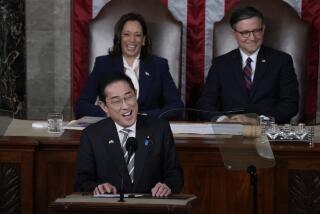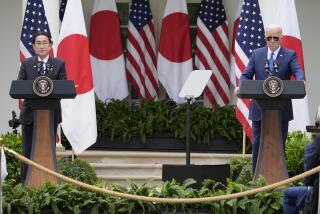Kaifu Woos U.S. Public to Soothe Trade Irritation : Japan’s Prime Minister Delivers Familiar Message During His Visit to U.S.
- Share via
BOSTON — Japanese Prime Minister Toshiki Kaifu reached out to mainstream America like a politician on the stump, tossing out the first baseball at Fenway Park, pumping the flesh at Plymouth Rock, and visiting prestigious universities.
By appearances, the essence of his diplomatic initiative was to restore good feelings in what might be called the world’s most antagonistic friendly alliance, bar none.
Indeed, with the trade imbalance hovering stubbornly above $50 billion a year--in Japan’s favor--economic tension has tended to overshadow the positive side of the relationship, particularly where strategic security ties are concerned.
But if there was a substantive message in Kaifu’s visit, which took him to San Francisco, Washington and Boston before he departed Monday for Mexico City, it was a familiar one, espoused by a succession of Japanese prime ministers: that both sides must make efforts to resolve trade problems, and that Japan will, as always, attempt to boost imports.
“We must try to be an import superpower,” Kaifu told a news conference Saturday, echoing a phrase used by President Bush in their meeting the previous day. He added that Japan must import more “not simply because we are being asked to do so by the United States, but because it will help raise our quality of life.”
Nothing to Say
Yet Kaifu, 58, who assumed office less than a month ago amid domestic political turmoil to become Japan’s third premier since May, revealed nothing new in the way of concrete measures or policy initiatives.
“There’s no substance to it. . . . Kaifu has nothing to say,” observed a veteran Japanese reporter accompanying the prime minister’s entourage. “This won’t fly back home--the Japanese people are not going to be fooled.”
To be fair, however, the gap between style and substance has far more to do with the constraints of the institution of the prime minister’s office than with Kaifu’s aptitude as a statesman. Never a chief executive like the U.S. president or a shaper of administrative policy like some European prime ministers, for the past four decades the Japanese prime minister has been at best an arbiter among rival factions of the ruling Liberal Democratic Party--the first among equals in an obscure game of inside baseball, a fulcrum for consensus building.
Bureaucrats Rule
It is the elite cadres of the bureaucracy that set the course and control the pace of change in Japan’s foreign and domestic policies, with varying degrees of input from the politicians.
“Neither the prime minister nor the prime minister’s office are policy-making bodies,” said Chalmers Johnson, a professor of political science at UC San Diego’s Institute of International Relations and Pacific Studies. “They basically reign over the political system, allowing the bureaucrats to rule.”
Despite Kaifu’s reputation as a skilled orator, Foreign Ministry officials essentially drafted the cautious speeches and remarks he was to deliver during his 10-day tour of the United States, Mexico and Canada.
What Kaifu contributed were the rhetorical flourishes and the personal touches. In San Francisco, for example, Kaifu recalled with nostalgia the almost childish thrill he felt when 27 years ago he fulfilled his “dream of driving an American car on the roads of the United States.”
In his major speech before the National Press Club in Washington, the prime minister of Japan lapsed into a maudlin tale of how his mother once gave him encouragement after he failed a junior high school entrance examination. He also waxed nostalgic over receiving chewing gum and chocolate from American GIs as a young boy during the occupation era.
“The idea is to give a face to Prime Minister Kaifu and also to give a face to Japan,” said a Foreign Ministry official. “He wants to build trust by explaining to the American public the thinking of the faceless, inscrutable Japanese.”
When it comes to Kaifu’s pledge to make Japan an “import superpower,” and by implication break down the structural characteristics of Japan’s distribution system and corporate culture, which critics allege retard market access by foreigners, it appears unlikely he will be able to deliver any concrete action.
The Bush Administration asked Kaifu for tangible signs of progress by next spring in the Structural Impediment Initiative consultations that began Monday in Tokyo. Kaifu gave no assurances other than to say both sides should make efforts.
‘Japanese Dan Quayle’
“Despite the propaganda of the Foreign Ministry, we have no indication that this guy is competent,” said Johnson, the UC San Diego political scientist. “The things that need to be done in Japan, he’s not capable of doing. He’s a seat-warmer, a flunky. He’s a Japanese Dan Quayle.”
Indeed, Kaifu’s status is hinged on a fluid domestic political situation, which undermines his already weak position as a vaguely empowered leader of government in the Japanese mold.
In early August, Kaifu was chosen by Liberal Democratic Party elders--under the pretext of a pro forma party caucus election--to succeed Sosuke Uno, the former foreign minister who resigned to take responsibility for the ruling party’s stunning defeat in the July 23 election for the Upper House of Parliament. Uno was embroiled in a sex scandal that compounded the public’s furor over political corruption and an unpopular consumption tax.
Uno’s predecessor, Noboru Takeshita, was forced to resign in May because of his role in the Recruit Co. bribery affair, which also tainted the names of former Prime Minister Yasuhiro Nakasone and nearly every top leader in the party.
Whether or not he is a caretaker prime minister manipulated from behind the scenes by Takeshita and other disgraced party bosses, as many knowledgeable observers suggest, Kaifu’s paramount job is to restore confidence in the beleaguered ruling party and lead it through general elections expected to be held as early as later this year.
In that respect, his wooing of the American public seemed designed for domestic Japanese consumption, much as his warm welcome by the Bush Administration appeared intended to help shore up the Liberal Democrats’ defenses against the ascendence of the Japan Socialist Party.
A Curious Mixture
He will need all the help he can get. An opinion poll conducted by Jiji Press shortly after Kaifu took office suggested that his Cabinet had only a 27.5% approval rating, the second lowest ever recorded by the agency for a new administration. The lowest rating went to Uno, Kaifu’s immediate predecessor.
Meanwhile, Kaifu’s performance on foreign soil, highly scrutinized in Japan for traces of charisma and leadership, has displayed a curious mixture of genuine spontaneity and wooden ritual. He joked about his predilection for polka-dot ties with President Bush and tried his hand at horseshoes during his brief stop at the White House. But intimacy and warm feelings were part of the advance script, long before the two men ever met and had an opportunity to determine whether they felt personal rapport.
“I was able to conduct talks with the President as if I were meeting an old friend,” goes the advance text of Kaifu’s departure remarks from the White House, handed out hours before Friday’s summit began.
Bush broke away from his vacation in Kennebunkport, Me., to meet Kaifu in the formal setting of Washington, in sharp contrast with his reception of Canadian Prime Minister Brian Mulroney, who showed up at the Bush summer home wearing a sweater.
Yet Kaifu scored points for his wife, Sachiyo, an outgoing and charming First Lady who breaks the mold of the demure and invisible Japanese woman.
In San Francisco, where more than 800 people purchased $75 dinner tickets to hear Kaifu speak at the Fairmont Hotel, Kaifu’s oratorical skills were filtered through a mumbling interpreter, evoking unenthusiastic applause and some stifled yawns.
“It sounded to me like a lot of rhetoric,” said an American executive of a Japanese-owned computer company in San Bruno, Calif. “I suppose I was surprised he even mentioned there was trade friction in the U.S-Japan trade relationship, but he didn’t seem to be dealing head on with any of the issues. I don’t think we can look to Mr. Kaifu for many changes back in Japan.”
More to Read
Sign up for Essential California
The most important California stories and recommendations in your inbox every morning.
You may occasionally receive promotional content from the Los Angeles Times.











